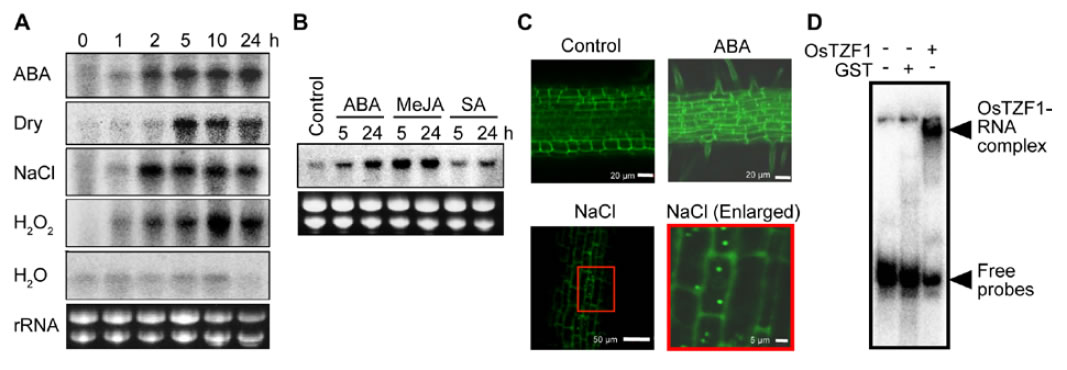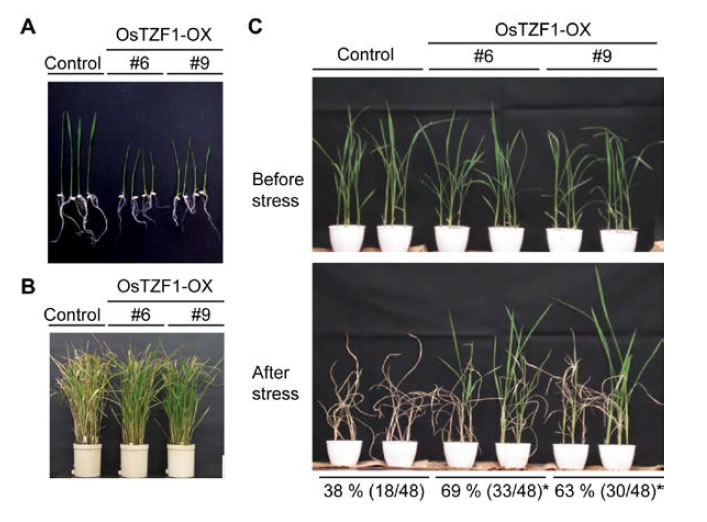Identification of RNA-binding protein that regulates growth, senescence and stress tolerance in rice
Description
Because plants cannot move freely, they must grow and live in place even under environmental stress conditions such as drought. Thus, plants have developed a mechanism to survive under such conditions by controlling the function of various genes. Under drought conditions, expression of the gene coding hydrophilic proteins, transcription factors, and various proteins involved in stress tolerance is induced. The role of stress-induced CCCH-type zinc finger proteins was not well understood. In this study, we revealed that a stress-inducible CCCH-type zinc finger protein OsTZF1 binds to RNA, and is involved in the regulation of growth, senescence, and stress tolerance.
Expression of OsTZF1 was induced by drought, high-salt stress, hydrogen peroxide, abscisic acid, methyl jasmonate, and salicylic acid (Fig. 1A, B). The expression was observed in callus, coleoptile, young leaf, and panicle tissues under normal growth condition. OsTZF1-green fluorescent protein localization was observed in the cytoplasm and cytoplasmic foci under stress condition (Fig. 1C). OsTZF1 binds to RNA, suggesting that OsTZF1 might be associated with RNA metabolism (Fig. 1D). Transgenic rice plants overexpressing OsTZF1 (OsTZF1-OX) exhibited delayed seed germination, growth retardation at the seedling stage, and delayed leaf senescence (Fig. 2A, B). OsTZF1-OX plants also showed improved tolerance to high-salt and drought stresses (Fig. 2C). Microarray analysis revealed that genes related to stress were regulated in the OsTZF1-OX plants.
OsTZF1 may serve as a useful biotechnological tool for the improvement of stress tolerance in various plants through the control of RNA metabolism of stress-responsive genes. Since the delay-like growth was observed when we overexpressed OsTZF1 constitutively, it might be necessary to utilize the suitable promoters such as stress-responsive promoters to improve environmental stress tolerance without causing growth retardation.
Figure, table
-
Fig. 1. Expression of OsTZF1, subcellular localization and RNA-binding activity of OsTZF1.
(A) RNA gel-blot analysis of OsTZF1 expression under different stress conditions.Expression was induced by abscisic acid (ABA), dry, high-salt (NaCl), and hydrogen peroxide (H2O2). Water (H2O) was used as the control.
(B) Hormone-dependent expression analysis of OsTZF1. Expression was induced by methyl jasmonate (MeJA) and salicylic acid (SA) as well as ABA.
(C) Subcellular localization of OsTZF1-green fluorescent protein (GFP).
(D) Binding analysis of the RNA fragment of stress-related gene and OsTZF1-GST fusion protein. OsTZF1-GST can bind to RNA but GST protein does not bind to RNA.These pictures were adopted from Jan et al. (2013) 1) (Copyright American Society of Plant Biologists; www.plantphysiol.org).
-
Fig. 2. Phenotypes of transgenic rice plants overexpressing OsTZF1 (OsTZF1-OX).
(A) Growth retardation observed in seedling stage.
(B) Delayed senescence observed in matured plants.
(C) Improved drought tolerance. Survival rates were shown below the pictures. Asterisks showed significantly higher survival rates than the control (P<0.01).
These pictures were adopted from Jan et al. (2013) 1) (Copyright American Society of Plant Biologists; www.plantphysiol.org).1) A. Jan, K. Maruyama, D. Todaka, S. Kidokoro, M. Abo, E. Yoshimura, K. Shinozaki, K. Nakashima, K. Yamaguchi-Shinozaki (2013) OsTZF1, a CCCH-Tandem Zinc Finger Protein, Confers Delayed Senescence and Stress Tolerance in Rice by Regulating Stress-Related Genes. Plant Physiology 161:1202-16.
- Affiliation
-
Japan International Research Center for Agricultural Sciences Biological Resources and Post-harvest Division
- Classification
-
Administration A
- Research project
- Program name
- Term of research
-
FY 2013 (FY 2007-FY 2013)
- Responsible researcher
-
Jan Asad ( Biological Resources and Post-harvest Division )
Maruyama Kyounoshin ( Biological Resources and Post-harvest Division )
Todaka Daisuke ( University of Tokyo )
KAKEN Researcher No.: 10533995Kidokoro Satoshi ( University of Tokyo )
KAKEN Researcher No.: 70588368Abo Mitsuru ( Meiji University )
KAKEN Researcher No.: 00272443Yoshimura Etsuro ( University of Tokyo )
KAKEN Researcher No.: 10130303Shinozaki Kazuo ( RIKEN )
KAKEN Researcher No.: 20124216Shinozaki Kazuko ( Biological Resources and Post-harvest Division )
ORCID ID0000-0002-0249-8258Nakashima Kazuo ( Biological Resources and Post-harvest Division )
KAKEN Researcher No.: 90343772 - ほか
- Publication, etc.
-
https://doi.org/10.1104/pp.112.205385
Jan, A. et al. (2013) Plant Physiol., 161: 1202-1216
- Japanese PDF
-
2013_B07_A3_ja.pdf683.63 KB
2013_B07_A4_ja.pdf312.66 KB
- English PDF
-
2013_B07_A3_en.pdf589.78 KB
2013_B07_A4_en.pdf382.05 KB
- Poster PDF
-
2013_B07_poster.pdf575.87 KB


